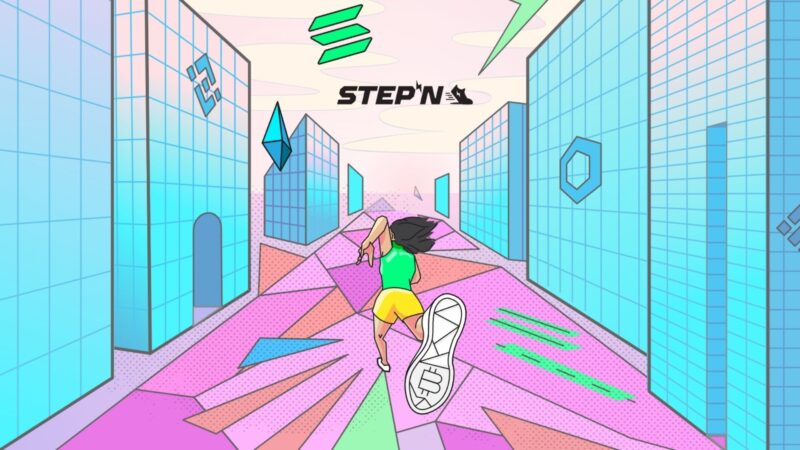Is STEPN a Ponzi that’s headed to zero? Are all these play-to-earn games headed to zero? This was one of the most debated questions in the entire crypto world. I had to take a look for myself, did a ton of research and what I discovered was shocking. In this article I’ll share with you everything that I found out about STEPN and answer the following questions. Is it a true Ponzi and would I ever invest in it? But first we have to start with play-to-earn projects because the criticisms against STEPN apply to every project in this niche.
Play-to-earn gaming is a really simple concept. You play some game, and you earn tokens in return that you can trade for real money. Usually the process goes as follows, first you buy some NFT to get started, the NFT could represent a character in the game or an item. Second, you earn their tokens as you play the game. Third, you can use those tokens to do in-game actions, like upgrade items, or you could cash out by selling them on the open market.
Sounds simple right? Then why do so many people call this a Ponzi? Well, it all comes down to demand. Like where does the money come from to let these players cash out? Is it only from new users and speculators buying their tokens, or is there real value that makes players want to buy these tokens to use them inside the game?
These game economies need to be self-sustaining. They need to have a careful balance between players buying and selling, or else things may just crash to zero once prices stall, and demand goes down. Unfortunately, most play-to-earn games these days do require a steady stream of new players for them to work. If demand drops and the liquidity pools all get drained by early players taking profits, then nothing’s left for the new players who just came in. Then that is the Ponzi part of it, because new players are literally coming in to let existing players exit.
This isn’t just theoretical. We’ve seen this happen to actual projects in this niche. Take Axie Infinity for example, the most popular play-to-earned game of all time. They absolutely rocketed during 2021 and reached an all-time high of around 2.5 million daily active users. However, after a while the prices of their tokens and NFTs inevitably dropped, and that caused their active players to drop as well. It wasn’t a tiny drop either, close to 75 percent of their daily players left. That confirmed that most players were just playing for the financial benefits, not because it was fun, and they wanted to.
It really looks like all these play-to-earn games focused too much on the earning aspect, and their tokenomics were never sustainable. But what does that mean for STEPN? Does that mean that they’re an unsustainable Ponzi, too? or were they able to learn from their predecessors, and build a game that’s more sustainable?
STEPN was a pioneer in the move-to-earn space which is pretty much the same as play-to-earn just instead of playing a game you do physical activity to earn tokens. Their whole idea is this, since you’re going move anyways, why not get rewarded for it?
To get started you need to download their mobile app, and then get an invite code from the telegram or discord. STEPN runs on Solana, you have to set up a Solana wallet in their app, send some SOL there, and use that to buy an NFT sneaker from their in-app marketplace. After you have one sneaker, you can start running, walking, or jogging to receive GST tokens. You can’t just work out forever though, there’s a limited amount of energy points that determines how long you can earn rewards for, once those run out you have to wait until they recharge.
STEPN run on a two token system. GST is their utility token that you earn from moving. It does not have a maximum supply cap, you use it for a ton of in-game actions like minting shoes, leveling up stuff, upgrading gems, etc. Then you have GMT Token, which is their governance token that has a maximum supply cap of 6 billion tokens. You can burn it for some in-game upgrades, like increasing the probability of minting better sneakers. In the future they also plan on letting you earn GMT when you have a level 30 sneaker or above.
That’s the basics but now let’s turn to the Ponzi debate. Let’s look at three areas in particular that could be unsustainable. For STEPN, the first has to do with token inflation. Inflation has to be carefully controlled because if the supply grows too much, then the value of each token decreases, and that leads to a lower payout for players, which could cause them to leave in droves. For GMT token, only 10% of its supply is circulating right now so there will be a lot more hitting the market in the future. Up to this point the team has only done some buy back and burns for GMT, but those were just one-off events and they’re definitely not a sustainable strategy.
Now, for GST that’s an even bigger problem because there’s no limit to the amount that can exist. The more users that join, the more GST is printed to reward them and that could lead to runaway inflation. To counteract this inflation, the team has to design great token sinks. These are just ways that the players can use GST, so that it stays inside the STEPN ecosystem and doesn’t go hit outside exchanges.
However, there’s a problem here. There are two types of sinks out there, and only one of them is good for the game long term. The first type are your net positive sinks, these reduce the circulating supply, but they increase the rate of emission. That means in the long haul, inflation still goes up. Most of STEPN sinks fall into this category as of right now. For example, if you spend GST to upgrade your shoes, that’s good because the supply is decreased. But it also increases your earning rate which means more GST will be printed to reward you.
On the other hand, net negative sinks also reduce the circulating supply, but they decrease the overall rate of emission, which means less inflation long term. These types of things are much better for sustainability. One way to create them is to give players fun things to spend their tokens on that isn’t related to their earning potential, so the STEPN team needs to urgently create a lot of these.
Prices going down due to inflation isn’t the only problem here, prices going up too quickly is also a major issue, and that’s the second unsustainable part. If GST prices spike too much, then existing holders or players are happy, but it also prices out new users and thus slows down growth for the game. Remember, you need to buy GST to mint new sneakers, but if those costs too much then no one can afford it. Therefore, this aspect needs to be carefully balanced to make sure that existing players do get good profits, but the price is also friendly for newcomers.
Lastly, the third unsustainable piece has to do with the number of NFT sneakers out there. The sneaker to user ratio is very important to keep our eyes on, because if that number gets too high which means too many sneakers out there per user, then it could lead to a death spiral.
Let’s say that we’re at a point where there are more sneakers than users, then that leads to less competition for each sneaker, and that means the price of the sneakers will fall. Why not just buy them from the marketplace instead of mint new ones using GST? Less people would buy GST for minting purposes which leads to lower token prices, and that leads to lower earnings for players, which means less people will want to play, and that leads to more sneakers out there than users. Which once again brings us to our original step and on and on it goes, you see how this flywheel could spiral out of control?
Since all these issues are out in the open, what’s the team going to do about them? It ultimately comes down to creating levers to control supply and demand and keep everything stable. If prices are dropping too much, they could increase demand or decrease supply. If prices are going up too much, they could pull the opposite levers. To control demand, the team can adjust the number of daily invite codes that are given out, decreasing that number slows the rate of growth, and the overall demand. To increase demand, they plan on building new features that make people want to play more, some ideas include buying carbon offsets with their treasury funds, so people who like the environment can feel good about playing the game. They’ve also talked about adding a leaderboard and other competition-based features. That way people may want to play to beat their friends rather than just focusing on maximizing earnings.
On the supply side if prices are rocketing too quickly, then the team can give out double earnings for some period of time to increase the supply and cool down the market. They could also adjust minting costs to include both GST and GMT, or even consider the USD value of GST so that is dynamically adjusted and not just the same flat fee of like 300 GST for example.
On the NFT sneaker side, they can reduce the supply by letting players combine or burn their lower-level sneakers to create higher level ones. This lets players upgrade their earning potential, but it also reduces the excess supply that could kick off the death spiral if things get out of hand.
I’m actually quite impressed with the STEPN team because they wrote a whole blog post on the sustainability of play-to-earn games. Clearly, they have been thinking about this a lot and they’re genuinely trying to create a game that’s not a Ponzi.
But does that mean I think they’ve succeeded, and I want to invest in them? No, not at all.
It’s super obvious that GMT’s hype is dying down. With significant inflation on the horizon, it could sell off even more. They’re also still at a massive 5 billion dollar fully diluted value, even after a 75% drop from all-time highs. I also think that they’re a long way from building a truly sustainable game. A lot of their features and tokenomic levers are still not out yet. They do have a shot at succeeding given their strategy and their track record, but it is an uphill battle and I’d rather invest after they’ve proven they can sustain for the long haul, or maybe I’ll just invest in a competitor that learns from STEPN, who copies their model once they figure it out how to create a game that works from day one.
Ultimately, it’s really hard to build a game that’s fun. These projects are trying to balance both fun and earning money so that’s doubly hard of a challenge. A lot of these projects right now are more like DeFi projects that make you click a few buttons to simulate the game part of it. I want to see us moving away from that and get more to the entertainment side of things. Personally, I’m optimistic but I’m going to take a wait and see approach when it comes to this niche.








